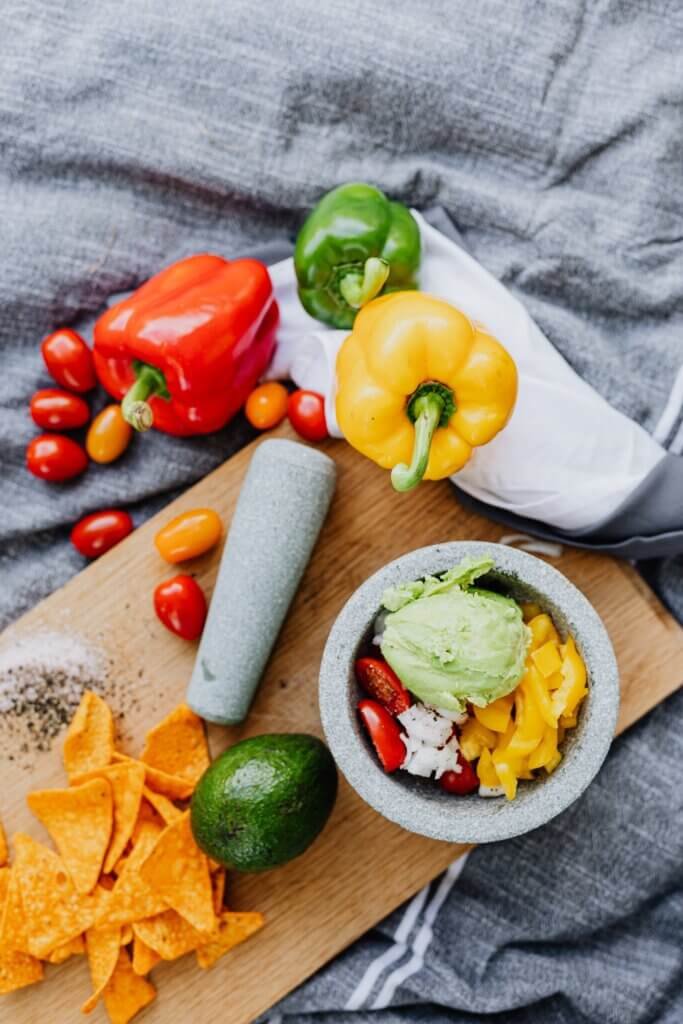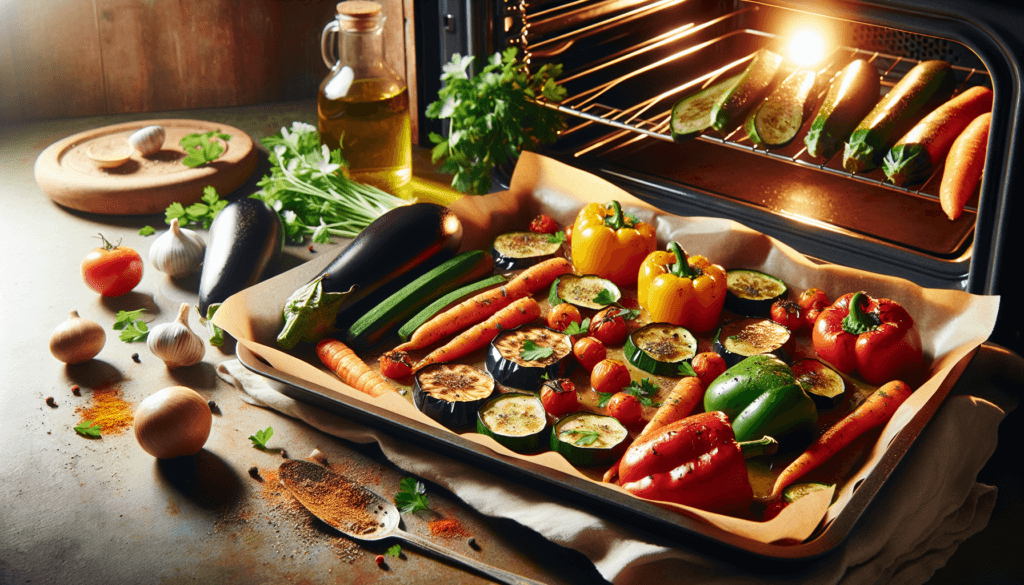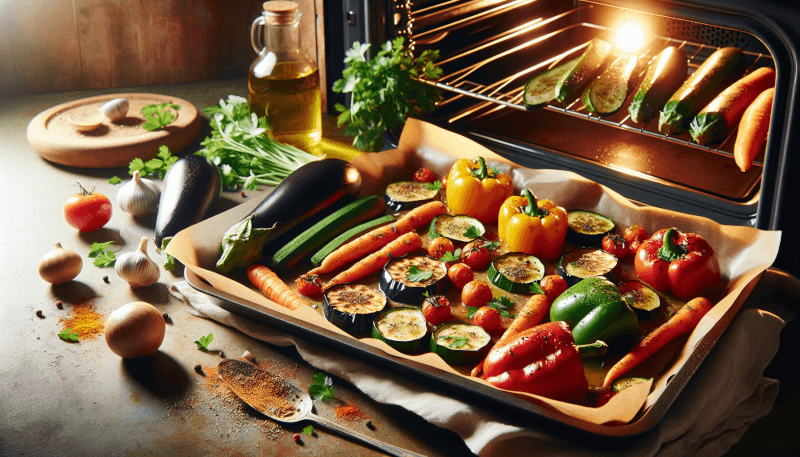Roasting vegetables can be a simple and delicious way to elevate your meals, but achieving that perfectly crispy and caramelized exterior can be a bit tricky. Fortunately, we’ve got you covered with some helpful tips that will take your roasted vegetables to the next level. From choosing the right vegetables to mastering cooking times and temperatures, we’ll guide you through the process to ensure your vegetables turn out perfectly every time. So grab your favorite veggies and get ready to impress with your roasting skills.
Choosing the Right Vegetables
When it comes to roasting vegetables, selecting the right ones is essential for achieving delicious results. To begin, opt for fresh and seasonal vegetables. Not only will they have the best flavor, but they will also roast more evenly. Look for veggies that are vibrant in color and firm to the touch.
Another important consideration is choosing vegetables with similar cooking times. This ensures that all the vegetables on your baking sheet will be perfectly cooked and ready to enjoy at the same time. For example, if you’re roasting root vegetables like potatoes and carrots, they have similar cooking times and will roast well together.
Lastly, it’s important to choose firm and dense vegetables for roasting. Vegetables like bell peppers, zucchini, and eggplant can become mushy when roasted, so it’s best to avoid them for this cooking method. Instead, opt for sturdy options like broccoli, cauliflower, Brussels sprouts, or butternut squash. These vegetables will hold their shape and develop a delicious caramelized exterior when roasted.
Preparation and Cutting Techniques
Before roasting your vegetables, it’s crucial to properly prepare and cut them to ensure even cooking. Start by washing your vegetables thoroughly to remove any dirt or debris. Once cleaned, make sure to dry them well, as excess moisture can hinder the caramelization process.
Next, consider whether you want to peel your vegetables or leave the skin intact. Many vegetables, such as potatoes, carrots, or butternut squash, can be roasted with their skins on for added texture and nutritional value. However, if you prefer a smoother consistency or are using vegetables with tougher skins, like onions or garlic, peeling them beforehand may be necessary.
Uniformly cutting your vegetables is also important for consistent roasting. Try to chop them into similar-sized pieces to ensure they cook evenly. If some pieces are significantly larger than others, they may require longer cooking times, leading to uneven results. Additionally, uniform cuts will provide an aesthetically pleasing presentation when serving the roasted vegetables.

Seasoning and Marinating
To elevate the flavor of your roasted vegetables, seasoning is a crucial step. Start by coating the vegetables with oil, such as olive oil or avocado oil. This not only adds flavor but also helps prevent sticking to the baking sheet. Use enough oil to lightly coat the vegetables but be mindful not to overdo it, as excessive oil can result in soggy vegetables.
In addition to oil, herbs, spices, or seasoning blends can be used to enhance the taste of your roasted vegetables. Consider using herbs like rosemary, thyme, or oregano, along with spices such as cumin, paprika, or chili powder. Seasoning blends like Italian herbs or Cajun seasoning can also add a flavorful twist. Experiment with different combinations to find your favorite flavor profile.
For those looking to take their roasted vegetables to the next level, marinating them can be a game-changer. Marinating involves soaking the vegetables in a flavorful liquid, such as a mixture of oil, herbs, spices, and acidic ingredients like vinegar or citrus juice. This process enhances the taste and creates a more depth of flavor. Simply place the vegetables in the marinade for at least 30 minutes or up to overnight before roasting.
Roasting Temperature and Time
To achieve perfectly roasted vegetables, it’s important to set the oven to the appropriate temperature. Preheat the oven to around 400°F (200°C) for most vegetables, as this temperature allows for a nice caramelization without burning. However, some vegetables may require higher or lower temperatures, depending on their natural sweetness or water content. For example, Brussels sprouts and broccoli can be roasted at a slightly higher temperature to bring out their caramelized flavor.
Determining the ideal roasting time can be a bit tricky, as it varies depending on the vegetable and the desired texture. Generally, root vegetables like potatoes and carrots will take longer to roast, around 30-40 minutes. On the other hand, softer vegetables like zucchini or bell peppers may only need 15-20 minutes. Keep a close eye on them and adjust the cooking time accordingly.
If you prefer your vegetables to have more crunch, roast them for a shorter time, while if you prefer a softer texture, extend the cooking time slightly. Remember, the key is to check on them frequently and monitor their progress to ensure they don’t overcook or become mushy.

Optimal Roasting Techniques
When it comes to arranging your vegetables on the baking sheet, it’s best to lay them out in a single layer. This allows for even heat distribution and ensures each piece roasts evenly. Avoid overcrowding the sheet, as this can lead to steaming instead of roasting, resulting in less caramelization and crispness.
To promote even cooking and browning, consider flipping or stirring the vegetables halfway through the cooking process. This ensures that all sides of the vegetables are exposed to the heat, resulting in a more uniformly roasted batch. Use tongs or a spatula to carefully flip the vegetables, being cautious not to burn yourself.
For better air circulation and crispier results, you may also choose to use a wire rack instead of a baking sheet. The elevated rack allows heat to circulate underneath the vegetables, preventing them from becoming soggy. This technique works particularly well for vegetables like Brussels sprouts or asparagus, as it helps achieve a delightful char and caramelization.
Achieving Crispy and Caramelized Results
To achieve the crispiest and most caramelized results, it’s important to ensure your vegetables are dry before roasting. After washing, make sure to thoroughly pat them dry to remove any excess moisture. This step is crucial because moisture prevents the vegetables from properly browning and creating that irresistible crispy exterior.
Additionally, using higher temperatures can aid in caramelization. Once your oven is preheated, consider increasing the temperature slightly to encourage browning. This technique works especially well for root vegetables like potatoes, carrots, or parsnips. The higher temperature enhances the natural sugars in the vegetables, resulting in a delightful caramelized flavor.
If you’re looking for some extra browning, feel free to add a sprinkle of sugar to your vegetables. This trick works particularly well with roasted carrots or sweet potatoes, as it enhances their natural sweetness and adds a beautiful caramelized color. Just be sure to use a light hand with the sugar to prevent overpowering the natural flavors of the vegetables.

Enhancing Flavor and Texture
While perfectly roasted vegetables are delicious on their own, there are several ways to enhance their flavor and texture even further. One option is to sprinkle grated cheese over the roasted vegetables. The residual heat from roasting will melt the cheese, creating a delightful cheesy crust on top of your veggies. Parmesan, cheddar, or feta are great choices to add an extra savory touch.
Another option is to add a drizzle of balsamic glaze or honey. These sweet and tangy additions can take your roasted vegetables to a whole new level. The balsamic glaze adds a rich, slightly acidic flavor, while honey brings a touch of natural sweetness. Drizzle them over the vegetables just before serving to create a perfect balance of flavors.
For added texture and crunch, consider topping your roasted vegetables with nuts or breadcrumbs. Toasted pine nuts, slivered almonds, or panko breadcrumbs can add a delightful contrast to the tender roasted vegetables. Sprinkle them over the veggies during the last few minutes of cooking or just before serving for an extra dimension of texture and flavor.
Avoiding Common Mistakes
While roasting vegetables is a straightforward process, there are a few common mistakes to avoid for the best results. One of the most important things to remember is to avoid overcrowding the baking sheet. When the vegetables are packed too closely together, they end up steaming instead of roasting. This prevents proper browning and can result in soggy and lackluster vegetables. Give them enough space to allow for even heat distribution and caramelization.
Using too much oil is another pitfall to steer clear of. While oil is essential for flavor and preventing sticking, excessive amounts can lead to oily and greasy vegetables. It’s best to use just enough oil to lightly coat the vegetables. If you’re concerned about them sticking to the baking sheet, consider using parchment paper or a silicone baking mat for easy release and cleanup without excessive oil.
Finally, make sure to accurately estimate the roasting time for your vegetables. Underestimating the cooking time can result in undercooked or crunchy vegetables, while overcooking them can lead to mushiness. Pay close attention to the texture and color of the vegetables as they roast, and make adjustments as needed. Remember, practice makes perfect, and with time, you’ll become more confident in determining the ideal roasting time.

Utilizing Leftover Roasted Vegetables
If you find yourself with leftover roasted vegetables, don’t let them go to waste! There are plenty of creative ways to incorporate them into other dishes. One option is to add them to salads or grain bowls. Roasted vegetables can add a tasty and nutritious element to your favorite salad combination or grain-based meal, providing a burst of flavor and texture.
Another idea is to blend the roasted vegetables into soups or purees. This works particularly well for denser vegetables like butternut squash or sweet potatoes. Simply add the roasted vegetables to a blender or food processor along with some broth or cream, and blend until smooth. The result is a velvety and flavorful soup or puree that can be enjoyed as a comforting meal.
Lastly, consider adding roasted vegetables to pasta dishes or stir-fries. They can add a depth of flavor and vibrant colors to these dishes. Toss them with cooked pasta and your favorite sauce for a satisfying pasta dinner, or stir-fry them with some protein and sauce for a quick and flavorful meal. The roasted vegetables will bring a unique twist to your favorite recipes.
Tips for Specific Vegetables
While the general tips and techniques outlined above apply to a wide variety of vegetables, there are a few specific tips for roasting certain types of veggies.
When it comes to roasting potatoes, achieving crispy edges is key. To do this, make sure to cut the potatoes into even-sized cubes or wedges. Toss them in oil and seasonings, then arrange them in a single layer on the baking sheet. Roast them at a slightly higher temperature, around 425°F (220°C), to encourage crispiness. Flip them halfway through cooking to ensure even browning on all sides.
To bring out the natural sweetness of carrots, roast them at a slightly higher temperature, around 425°F (220°C). The higher heat caramelizes the sugars in the carrots, resulting in a deliciously sweet flavor. Consider adding a sprinkle of cinnamon or nutmeg for an extra touch of warmth and fragrance.
When it comes to roasting broccoli, many people are pleasantly surprised by the transformation from a simple steamed vegetable to a flavorful caramelized delight. To achieve this, cut the broccoli into florets and toss them in olive oil, salt, and pepper. Arrange them in a single layer on the baking sheet and roast at around 400°F (200°C) for about 15-20 minutes, flipping halfway through. The result is a tender, slightly crispy, and perfectly caramelized vegetable.
Butternut squash is known for its creamy texture, and roasting it enhances this quality even further. To prepare butternut squash for roasting, peel it, remove the seeds, and cut it into cubes. Toss the cubes in oil, salt, pepper, and any additional spices or herbs you prefer. Roast them at around 400°F (200°C) for 25-30 minutes, or until the squash is tender and lightly caramelized. The result is a deliciously creamy and rich vegetable that pairs well with a wide range of flavors.
In conclusion, roasting vegetables is a versatile and delicious cooking method that can bring out the natural flavors and textures of various vegetables. By choosing the right vegetables, properly preparing and cutting them, and following optimal roasting techniques, you can achieve perfectly roasted vegetables every time. Whether you’re a fan of crispy and caramelized edges or prefer a softer texture, experimenting with different seasonings and techniques will help you create flavorful and satisfying dishes. So go ahead, grab some fresh vegetables, heat up your oven, and embark on a culinary journey of delicious roasted vegetables.



